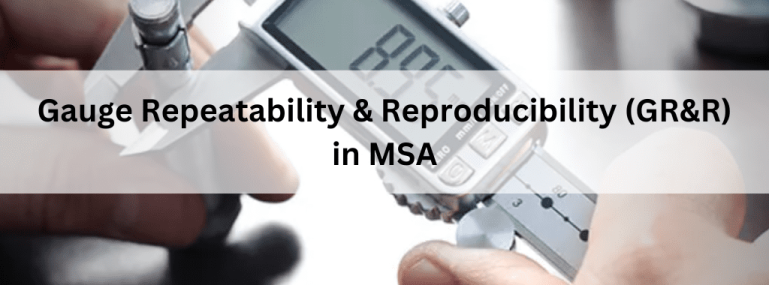Measurement system accuracy (MSA) can be defined as the capability of a measurement system to measure with high accuracy and precision (Gage Repeatability & Repeatability). An MSA is one of the major key elements of the PPAP (Production Part Approval Process) and is an integral part of the process. It is a statistical tool that allows one to obtain information about the quality of data by analyzing the measurement system. As a result of this statistical tool, you will be able to determine the accuracy of the measurement, and this will help you identify the error in either the instrument or the appraiser.
Gauge Repeatability & Reproducibility (GR&R)
The repeatability of a measurement is the amount of variation in measurements that can be obtained with a measurement instrument when it has been used several times by the same appraiser. In this case, the same characteristic must be measured while the same part has the same characteristic. It is common to refer to repeatability as equipment variation, and it is the most common cause of variation in successive trials under defined measurement conditions, as well as in successive experimental conditions.
The term reproducibility is used to describe the variability between appraisers when it comes to appraisals. Generally, reproducibility is defined as the variation in the average of measurements made by different appraisers using the same measuring instrument and using different methods of making the measurements. In this case, the same characteristics are measured on the same part in the same way. This is often true for manual instruments influenced by the operator’s skill.
It aims to accomplish the following objectives:
- An assessment of how much error is present in the measurement as a result of the measurement process itself will be done.
- Measure the variability of the measurement system and quantify it.
- This is applicable to both attribute data and variable data.
It is used on the critical inputs and outputs prior to collecting data for analysis.Conducting MSA reduces the likelihood of passing a bad part or rejecting a good part.
In the MSA GR&R study, repeatability and reproducibility are used to evaluate the accuracy of a gauging instrument. The technique includes taking a chain of measurements to certify that the output is the same value as entered. Furthermore, it is required that the same measurements be acquired under the same operating conditions over a defined period, under the same conditions.
Each type of Gauge R&R study has a different objective. In gauge R&R, types may vary depending on the availability of data and types of tests, such as destructive and non-destructive tests.
Crossed Gauge R&R:

A crossed study is the most general sort of Gauge R&R look at is most usually used when we can able to instruct every appraiser to measure every element in a fixed wide variety of times. And additionally, it is utilized in non-destructive situations when parts are non-destroyed throughout the measurement and may be measured two to three times with the same part. This study can be conducted only for variable gauges and not used for attribute gauges.
Nested Gauge R&R:

This method is used for destructive type parts because the test will destroy the part. In this method, only one appraiser measures every part. One of the problems in nested Gauge R&R is to perceive a batch of produced parts that is so close to the authentic that it reasonably may be assumed the components within the batch are the same component. The important thing to being able to run destructive Gauge R&R examination is the assumption that a batch is homogeneous.
But if we can handiest capable of achieving two similar components at a time then each appraiser must measure different parts. In this example we need to deal with the facts very differently and use a nested have a look at in which each appraiser measures a unique group of parts.
Expanded Gauge R&R:

Expanded Gauge R&R study is used when we need to consider more factors than appraiser and part. In general crossed and nested Gauge R&R study deal with only two factors (Operator and part). In theory, we should consider only these two factors. But other factors may also play a major role in Gauge R&R study. As an example, environmental elements which include temperature and humidity are crucial for laser-based units, and ambient light will be tremendous for non-contact scanning.
ComplianceXL’s supplier verification process includes validation of the MSA, ensuring that only accurate results are used in the PPAP. This way, the PPAP can be completed with certainty, meeting the requirements of production control and customer satisfaction. The process also helps to avoid costly errors and rework. MSA is an essential part of the PPAP, and ComplianceXL ensures that customers get the best results. Get in touch with us today!
FAQs:
1.What is the significance of GR&R in MSA, and why is it so important?
A measurement system’s capability and reliability can be determined by GR&R. GR&R ensures accurate and consistent measurements by assessing repeatability (consistency) and reproducibility (agreement). Making informed decisions based on measurement data and maintaining quality control is crucial.
2.In what ways might GR&R vary from one region to another?
Measurement results are affected by several potential sources of variation in GR&R analysis. Among them are equipment variability, operator technique, environmental conditions (temperature, humidity, etc.), part placement and alignment, measurement resolution, and operator-gauge interaction. Identifying and minimizing these sources of variation improves measurement system reliability.





